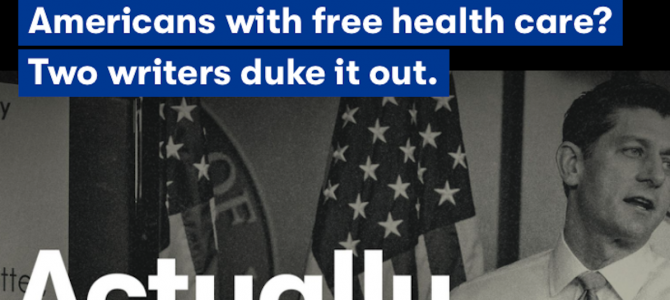Yesterday, I participated in an online debate series hosted by Mic. The question was: should the government provide all Americans with free health care, or step out of the equation entirely and allow market competition to keep health care affordable for consumers?
My opponent was Maria Svart, national director of the Democratic Socialists of America, who argued for “Medicare for all.” I argued, not that the government should step out of the equation entirely, but that a freer health care market with less government intervention would solve many of our health care problems.
The debate, part of a Mic series called “Actually,” was three rounds, no more than 200 words per writer per round, and all responses were written in a single day. At the end, Mic posted a poll (open until 1:30pm EST today) for readers to weigh in on whose argument was more convincing.
.@johnddavidson @FDRLST @DemSocialists Who won the health care debate between @DemSocialists’ Maria Svart and @FDRLST’s @JohnDDavidson? https://t.co/MZifVNEH9N
— Mic (@mic) March 30, 2017
Below are my entries in the debate. The entire debate, including my opponent’s entries, is here.
We Don’t Have A Free Market Health Care System
For decades, government policies have made health care much more expensive that it should be—from the tax exemption for employer-sponsored health insurance (a relic of WWII wage controls), to the creation of Medicare and Medicaid in 1965, to EMTALA in 1986 (which guaranteed emergency room care to everyone), to the Affordable Care Act today.
All these government interventions have driven up health care costs to the point where many Americans simply can’t afford basic coverage, even under the ACA, which did nothing to address underlying cost drivers but did plenty to drive up the price of premiums through heavy-handed regulations.
We’ve never really had a “free market” health care system in the modern era. What we’ve had is more like crony capitalism. We spend hundreds of billions every year subsidizing employer-sponsored coverage, which mostly benefits large employers, while also paying for a Medicare entitlement that includes every American over age 65—even billionaires.
We could create a market-based system that subsidizes those who need it while driving down costs for everyone else. But it would mean disrupting the cronyism that has dominated American health care for 70 years. So far, neither party has been willing to do that.
How Health Insurance Hides The True Cost Of Care
The real left-right debate in health care is whether or not you can have a functional “market” in health insurance and medical care. Svart insists you can’t because sometimes we need care in an emergency and we can’t price compare.
But this argument misunderstands how markets work, and especially our distorted health insurance markets. The vast majority of medical care we consume isn’t in the ER, and we could easily shop around for the best deal—if we had prices to compare. As it is, the U.S. health care system disconnects patients from the cost of their care. How much is an MRI? Why does a single aspirin cost $25 in a hospital? Why does sinus surgery cost $5,885 in one facility and $33,505 in another?
You can’t have a functioning market without clear price signals, and the way we treat health insurance hides prices and divorces us from the cost of care. Think of it this way: if car insurance were like health insurance, premiums wouldn’t just cover damage from accidents, they would cover gas, oil changes, tire replacement, windshield wipers, and so on. No one would know what those things cost individually, but premiums would be very high.
A Freer Health Care Market Would Drive Costs Down
The real cost drivers in health care aren’t really insurance companies or big pharma, but the hospital systems that insurers have to have in their networks. Hospitals charge high prices because insurers will pay whatever they ask. Large employers divert employee compensation into tax-free health benefits, pay premiums to insurers who in turn pay hospitals, and patients never know how much anything really costs.
We have to break this cycle. There’s plenty of ways to do it that wouldn’t leave working Americans without coverage or care. In fact, we could ensure every American had government-funded catastrophic coverage—for those times they unexpectedly end up in the ER—while shifting to a competitive market system for most everything else.
Prices for routine medical care would plummet, just like they have for cosmetic procedures not covered by insurance. Thanks to competition and technology, LASIK eye surgery cost $2,200 per eye in 1998 but only costs about $300 per eye today.
Svart says health care is a public good. Fine. So is water. We can make sure everyone has access to clean running water while also allowing the market to sell it anywhere from 99 cents to $100 a bottle.









